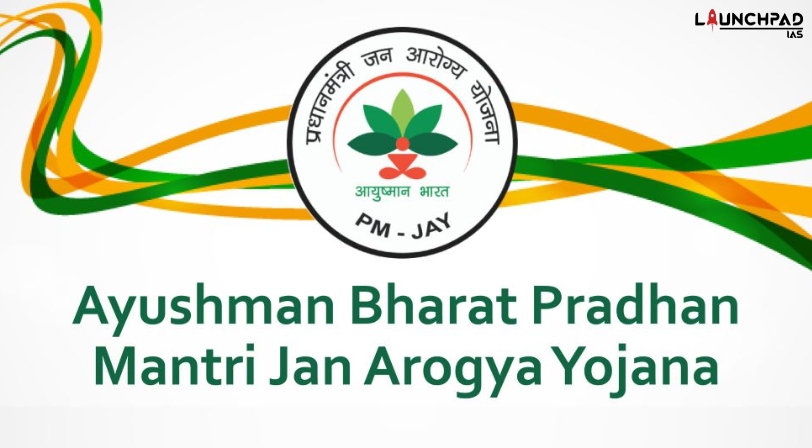About:
- Pradhan Mantri Jan Arogya Yojana PM-JAY is the world’s largest health insurance scheme fully financed by the government.
- Launched in February 2018, it offers a sum insured of Rs.5 lakh per family for secondary care and tertiary care.
- Health Benefits Packages cover surgery, medical and daycare treatments, cost of medicines, and diagnostics.
Beneficiaries:
- It is an entitlement-based scheme that targets the beneficiaries as identified by the latest Socio-Economic Caste Census (SECC) data.
- The National Health Authority (NHA) has provided flexibility to States/UTs to use non-Socio-Economic Caste Census (SECC) beneficiary family databases with similar socio-economic profiles for tagging against the leftover (unauthenticated) SECC families.
Funding:
The funding for the scheme is shared – 60:40 for all states and UTs with their own legislature, 90:10 in Northeast states and Jammu and Kashmir, Himachal and Uttarakhand, and 100% Central funding for UTs without legislature.
Nodal Agency:
- The National Health Authority (NHA) has been constituted as an autonomous entity under the Society Registration Act, 1860 for effective implementation of PM-JAY in alliance with state governments.
- The State Health Agency (SHA) is the apex body of the State Government responsible for the implementation of AB PM-JAY in the State.
PM-JAY Eligibility Criteria
PM-JAY is an entitlement-based scheme. The eligible families are fixed based on the deprivation criterion in the Socio-Economic Caste Census (SECC) database.
The detailed categories in both urban and rural areas are given below:
- Families with only 1 room with a kutcha roof and walls.
- Families with no adult members between the ages of 16 and 59.
- Households headed by females with no male adult members between the ages of 16 and 59.
- Families with disabled members and no adult able-bodied members.
- SC/ST households.
- Landless households derive a major chunk of their income from manual casual labor.
- Rural area families with any of the following:
- Households with no shelter
- Destitute
- Living on alms
- Manual scavenging
- Primitive tribal groups
- Legally released bonded laborer
- In the urban areas, 11 occupational categories are eligible for the scheme:
- Beggar/Ragpicker/Domestic worker
- Street vendors/hawkers/cobblers/Other service providers working on the streets
- Construction worker/Plumber/Mason/Labourer
- Painter/Welder/Security guard
- Coolie and other head-load worker
- Sweeper/sanitation worker
- Mali/home-based worker
- Artisan/handicrafts worker/Tailor
- Transport worker/driver/conductor/helper to driver and conductor/Cart puller/rikshaw puller
- Shop worker/assistant/Peon in small establishment/Helper/delivery assistant/Attendant/waiter
- Electrician/Mechanic/assembler/repair worker/Washerman/Chowkidar
- According to the data in the SECC 2011, certain beneficiaries are excluded. They include households with motorized vehicles, fishing boats, that pay income tax/professional tax, a refrigerator, landline phones, an earning member who earns more than Rs.10000 per month, owning land above a certain limit, government servants, etc.
PM-JAY Benefits
PM-JAY is a visionary scheme that aims at the fulfilment of the concept of Universal Health Coverage (UHC). Benefits are discussed below:
- It will reduce medical expenditure for many families, which is currently, mostly out-of-the-pocket expense. Eligible families can avail of quality medical services without getting into debt.
- The insurance cover provided by this scheme includes items that are generally excluded from standard medi-claims (for example, pre-existing conditions, internal congenital diseases, and mental health conditions).
- The scheme requires hospitals to maintain a certain minimum standard.
- Insurers and third-party administrators will have access to the large new market that opens up because of the scheme.
- The scheme has the potential to initiate wide reforms in India’s healthcare system.
- After one year of the scheme’s beginning, beneficiary families are said to have saved over Rs.13000 crores.
- Over 60% of the treatments have been done by private hospitals. The private sector has played an active role in this scheme and they have also benefitted from it. In many Tier II and III cities, private hospitals have observed increased footfall.
- Economically weaker sections of society can have access to quality healthcare services without financial hardships.
- The scheme has also resulted in the creation of more jobs. In 2018, it generated more than 50000 jobs. This number is expected to increase as the government is planning to build 1.5 lakh HWCs by 2022.
- 90% of the jobs are in the health sector and the remaining in allied sectors like insurance.
- The scheme is supported by a robust IT framework.
- It supports beneficiary identification, maintains treatment records, processes claims, addresses grievances, etc.
- There is a fraud detection, prevention, and control system at both the central and state levels, which is critical for preventing fraud.
Related Links:


